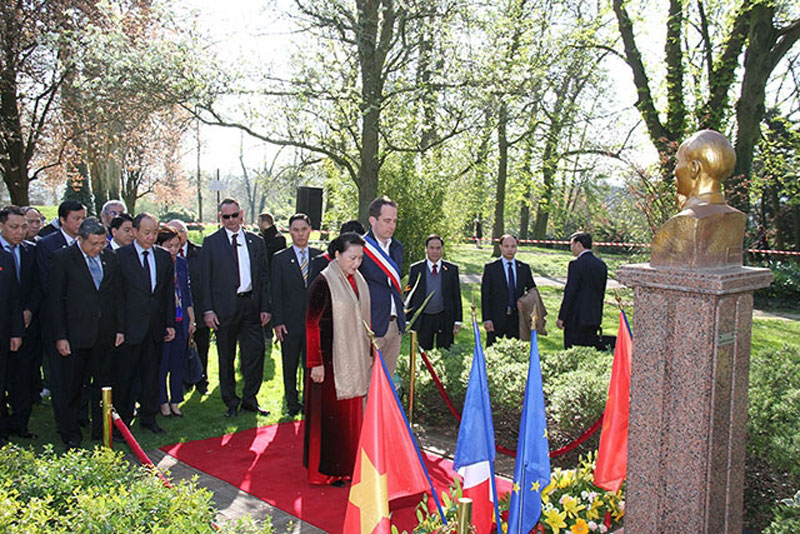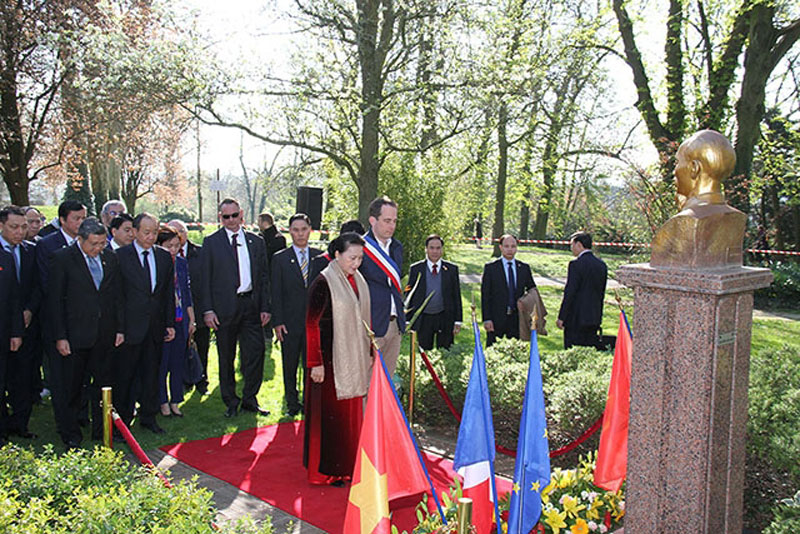
During her official visit to France, National Assembly (NA) Chairwoman Nguyen Thi Kim Ngan and the Vietnamese NA delegation on March 31st laid a wreath and paid homage at President Ho Chi Minh statue, planted a tree and visited Ho Chi Minh space at Montreau park in Montreuil city.

NA Chairwoman Nguyen Thi Kim Ngan, Vietnamese NA delegation and Montreuil city leaders lay a wreath at President Ho Chi Minh statue.
In
her autograph book, she wrote that the delegation was moved to tears feeling
Uncle Ho’s hardships during his national salvation process, and expressed
thanks to Montreuil city for setting up space for preserving Uncle Ho’s
documents and exhibits.
Inaugurated
on May 19th, 2000, to mark Uncle Ho’s 110 birthday, the space
has become a diplomatic sightseeing location. From July 14th, 1921, to June 1923, President Ho Chi Minh lived
and worked as a photographer under the name Nguyen Ai Quoc at No. 9 Compoint
alley in Paris’ district 9. In 1987, when the house where President Ho Chi Minh
lived was removed, the Vietnamese Embassy in France suggested Montreuil city
keep exhibits of President Ho Chi Minh. In 1988, the exhibits were re-collected
and on show until 1995 at the Museum of Contemporary History.
Re-built
in 2000, the room exhibits many precious remembrances about Uncle Ho, including
the door and plate for house No. 9, basin, photographic card, and the card as a
member of the French Communist Party. On the wall leading to the room hangs
photos, some front pages of newspapers and Uncle Ho’s letters to members of the
French Communist Party such as Jacques Duclos, Maurice Thorez and Etienne
Fajon. In the autograph book, visitors wrote in different languages.
The sacred exhibits and images about President Ho Chi Minh, a
national liberation hero and a world cultural celebrity, respectfully kept at
Ho Chi Minh Space, highlight a period in his life of revolution, encouraging
generations to act for solidarity, friendship and cooperation among nations;
for happiness, peace, national independence, democracy, sustainable development
and social progress in the world.
Source: DCS
In the spirit of "Party members go first, the people follow”, all households of Party members in the Doan Ket sub-region in Da Bac town, Da Bac district, voluntarily removed gates and fences, and donated land when the road expansion project passed through their properties. Inspired by their example, 68 households in the sub-region quickly followed suit, contributing over 1,400 sq.m of residential and perennial cropland to widen the main road through the residential area. The exemplary role of Party members in Doan Ket stands as a shining example of studying and following President Ho Chi Minh’s thought, morality, and lifestyle.
The Hoa Binh provincial People's Committee held a monthly meeting on May 29 to assess the implementation of socio-economic development tasks in the first six months of 2025, the progress of key projects, and some other important issues.
During his lifetime, President Ho Chi Minh always expressed his deep affection and special concern for children and youth. He once emphasized: "Caring for and educating children well is the responsibility of the entire Party and the entire people”; "First of all, the family (i.e. grandparents, parents, siblings) must do this job well”. "the Party Committees…, the Children’s Committee, the Youth Union, the education sector, and all related organizations must have specific plans to ensure children grow healthier and more progressive”. His teachings has been remaining valuable and serving as the guiding principles in the work of protecting, caring for, and educating children. In line with this ideology, Hoa Binh Province has continuously been prioritizing and investing resources in the well-being of children in recent years.
Mr. Nguyen Phi Long, the alternate Member of the Party Central Committee and Secretary of the Provincial Party Committee chaired the meeting of the Standing Committee of the Provincial Party Committee to provide opinions on several investment projects within the province. There was the attendance of Ms. Bui Thi Minh, the Permanent Deputy Secretary of the Provincial Party Committee and Chairwoman of the Provincial People’s Council; Mr. Bui Đuc Hinh, the Deputy Secretary of the Provincial Party Committee and Chairman of the Provincial People’s Committee and other members of the Standing Committee; the leaders from other departments, agencies, and some localities.
The Standing Board of the Vietnam Fatherland Front (VFF) Committee of Hoa Binh province held a meeting on May 28 to honour outstanding village elders, village heads, and reputable individuals from local ethnic minority and religious communities.
In mid-May, the provincial Museum organised an exhibition named "Duoi la co Dang Cong san Viet Nam quang vinh” (Under the flag of the glorious Communist Party of Vietnam). This meaningful activity took place in the joyful atmosphere to celebrate the country's major holidays and the Party congresses at all levels for the 2025-2030 term, towards the 14th National Party Congress.



